By Nadine Armstrong, carsales.com.au
Saving the planet doesn’t always have to cost the earth. The Mitsubishi Outlander plug-in hybrid, in entry-level ES model grade, is a perfect example of this, providing a budget-friendly gateway into the future of battery-electric motoring.
With a pared-back list of standard equipment and a spacious cabin, the most affordable Outlander PHEV prioritises practicalities and safety over high-tech creature comforts, making it an attractive proposition for budget-conscious families.
Let’s find out why.
Range finder
The recently updated 2023 Mitsubishi Outlander range offers a wide range of models, with 13 different variants available across five trim levels: the entry-level ES and LS models, mid-spec Aspire and Exceed and the flagship Exceed Tourer.
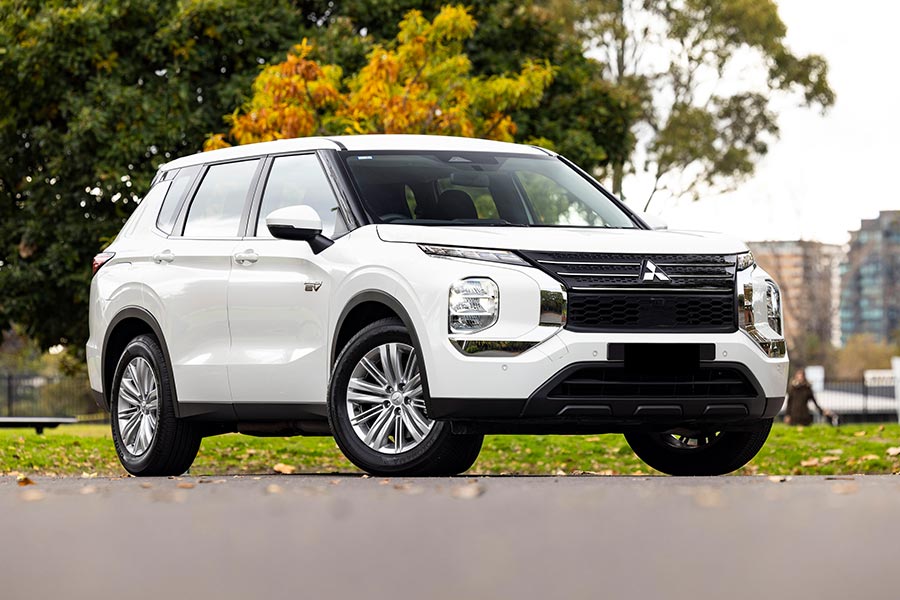
Then there’s the choice of either having two-wheel drive (in ES, LS and Aspire model grades) or all-wheel drive (across all five trim levels) with a conventional petrol engine, or the exclusively all-paw plug-in powertrain with a petrol engine linked to two electric motors.
All ES models are only available with a five-seat configuration, while all other model grades (with the petrol engine) feature a 5+2 seating arrangement with an additional third row that can be used for occasional transport of extra passengers.
The Outlander PHEV can only be had in four model grades with the ES and Aspire offered only as five seaters, while the higher spec Exceed and Exceed Tourer comes standard with the 5+2 set-up.
Pricing for the Outlander PHEV models start at $56,490 plus on-road costs for the ES model we’re testing here, and top-out at $70,990 (plus ORCs) for the flagship Exceed Tourer.
That’s a sizeable premium ($16,750 in the case of the ES) over the equivalent petrol-powered models, but it can be offset by the Federal Government’s Electric Car Discount policy that eliminates fringe benefits tax for electric and plug-in hybrid vehicles that cost less than the $89,332 luxury car tax threshold.
This can create a significant reduction on the price of weekly payments, and makes leasing an EV or PHEV more attractive and financially viable.
That said, the Outlander PHEV is almost in a league of its own with the MG HS EV+ the only other mid-size SUV offered in Australia with a plug-in hybrid powertrain. There are other options that a larger, like the Kia Sorento PHEV, and smaller such as the BMW X2 that just sneak under the FBT exemption ceiling.
All the basics
The second-generation Mitsubishi Outlander’s exterior design is more modern and distinctive than its predecessor with good proportions. And the plug-in models, including the ES, are easily identified by the PHEV badging on its flanks and the tailgate.
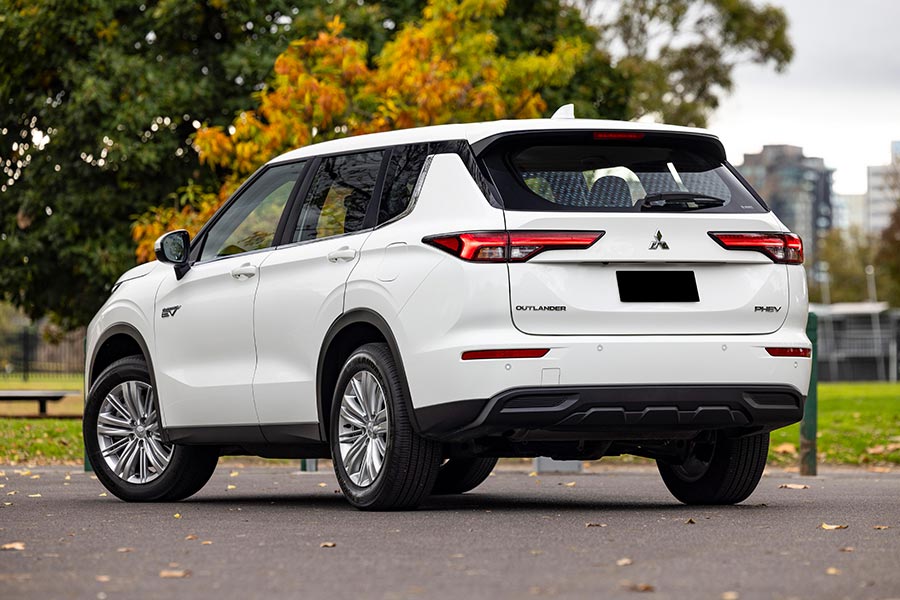
The Outlander ES rides on 18-inch alloys, while a rear spoiler, LED headlights and daytime running lights are standard, as are manually adjusted front seats with cloth trim, dual-zone climate control and a rear-view camera.
Strangely though, considering it has a push button start function, the Outlander ES misses out on keyless entry, which proved to be hassle having to search for the key fob in a handbag packed to the brim. Few omissions cut that deep when you’ve got your hands full wrangling the kids.
Despite being the cheapest model in the plug-in range, the Mitsubishi Outlander ES equipment list is, otherwise, satisfactory.
The 2023 Outlander is backed by Mitsubishi’s 10-year/200,000 kilometre warranty (as long as you service with Mitsubishi) with service intervals at 12-months or 15,000km.
Mitsubishi’s 10-year capped price servicing schedule sees owners pay $1845 for five years or $5090 after 10 years and the Outlander’s battery pack is covered by an eight-year/160,000km warranty.
Simply spacious
Mitsubishi’s cheap and cheerful reputation leans towards the latter in this instance – especially in this entry-level ES.
While it feels well built, with excellent fit and finish, the cabin is a little drab. The manual-adjust cloth seats and matching door trims somewhat soften the tactile elements of the cockpit, but they cannot mask the swathes of low-brow plastics and robust vinyl elsewhere throughout.
The ergonomics are spot-on though with plenty of adjustment in the driving position, and you’ll find two cup holders, large in-door storage, a lidded armrest and centre console oddment storage with access to USB-A and -C charge points as well as a 12-volt outlet.
The second-row seating is elevated, providing good outward vision and the seats are comfortable and offer enough space for three occupants. The fold-down centre armrest doubles as a thru-load to the boot, which feels a little untidy.
There are two ISOFIX positions and three top tether anchors for child restraints, the middle one extending from the roof. There’s a light, two directional air vents and seat back pockets, but no charge outlets.
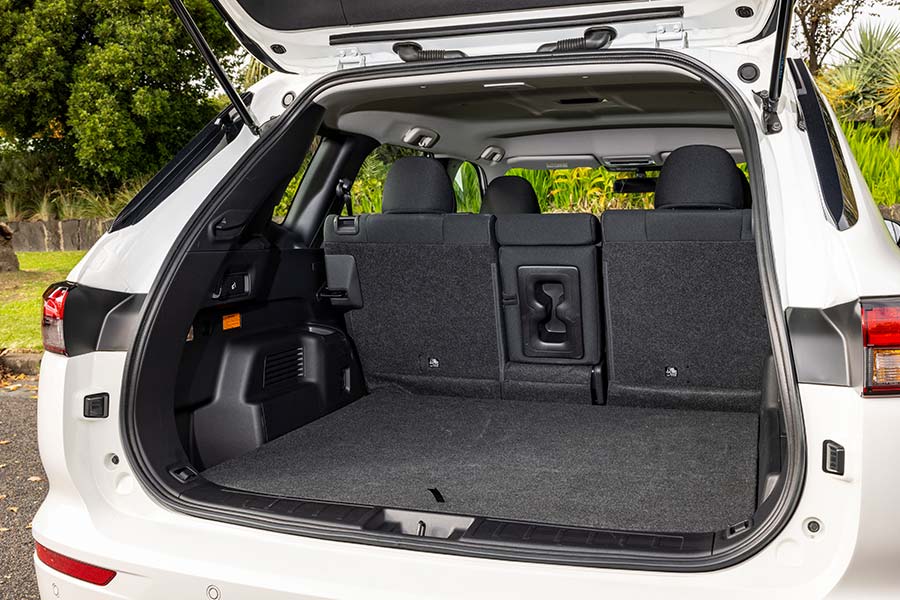
The manually operated tailgate reveals a sizeable 478-litre boot that grows to 1461 litres with the second-row seats folded flat (but not entirely so) which can easily be done from the boot.
There’s a light, two bag hooks, a 12-volt outlet and four anchor points, though the cargo cover of higher-spec models is missing. All PHEV models have a tyre repair kit in place of a spare tyre.
Upgraded safety
Following the initial launch in 2022, Mitsubishi has upgraded the Outlander range for 2023 with additional safety features added to the ES model that include automatic high beam headlights, autonomous rear braking and rear cross-traffic alert.
These are on top of the previously standard suite of active features that consists of autonomous emergency braking with pedestrian and cyclist detection, emergency lane assist, lane-departure warning and lane-keep assist, blind-spot warning, traffic-sign recognition and driver attention alert.
The airbag count includes dual front and side, curtain, front centre and driver’s knee, which helped the Outlander score a maximum five-star ANCAP safety rating in 2021.
No frills tech
As we’ve already outlined, the Outlander PHEV ES is a no-frills package. But it has the basics covered.
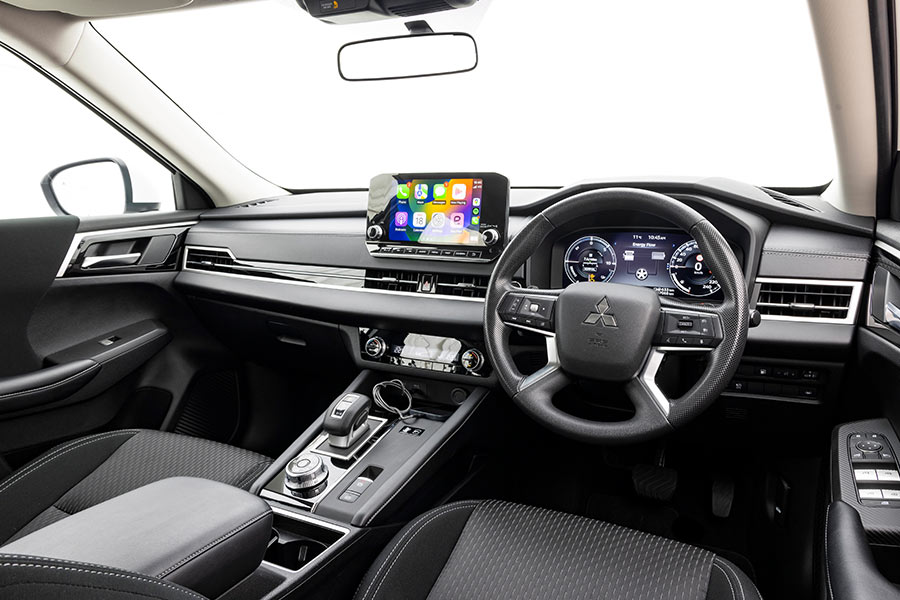
The 9.0-inch touchscreen display in the centre of the dash incorporates AM/FM/DAB+ digital radio through a six-speaker audio system, has sat nav, Bluetooth connectivity and smartphone mirroring for Apple and Android devices.
There’s also a reversing camera with front and rear sensors, but the screen resolution feels old and well behind the competition. The 360-degree camera found in higher-spec models would be a handy addition.
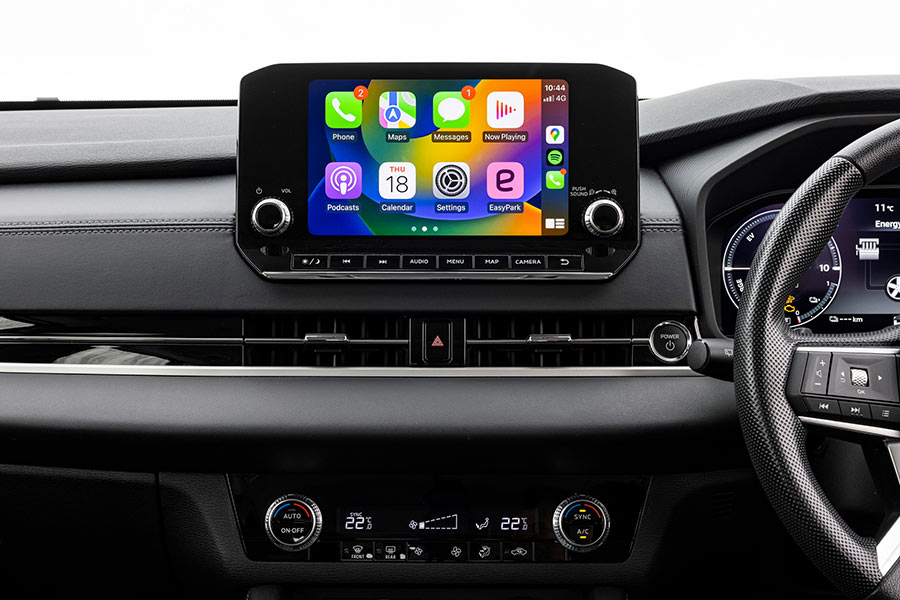
The larger 12.3-inch digital instrumentation display is a higher quality and showcases the efficiency values of the powertrain – such as highlighting the energy flow between the engine, electric motors and the battery pack – in easy-to-understand graphics.
Triple treat
The 2023 Mitsubishi Outlander PHEV ES combines a 2.4-litre naturally-aspirated four-cylinder engine with two electric motors – one on the front axle and one on the rear.
The engine, on its own, produces just 98kW and 195Nm but when linked with the additional 85kW from the front motor and 100kW from the rear motor, the Outlander has a combined maximum output of 185kW and 450Nm – making it the most powerful version in the range.
Drivers can choose between four operating modes – Normal, EV, Save and Charge – to adjust how the engine, electric motors and battery interact with each other. The Normal setting is a simple set-and-forget mode that allows the computers to optimise the balance, while EV switches off the petrol engine completely. The Save mode does the opposite and shuts down the electric motors to conserve the battery charge for when it is required and the Charge mode will use the engine and regenerative braking to replenish the battery while on the move.
Speaking of which, the power of regenerative braking – which uses the wasted energy under deceleration to create electricity back into the battery – can be tailored through six levels, with the maximum setting providing one-pedal driving, meaning the vehicle will come to a complete standstill without using the conventional brake pedal.
The numbers game
The 2023 Mitsubishi Outlander PHEV produces some impressive numbers.
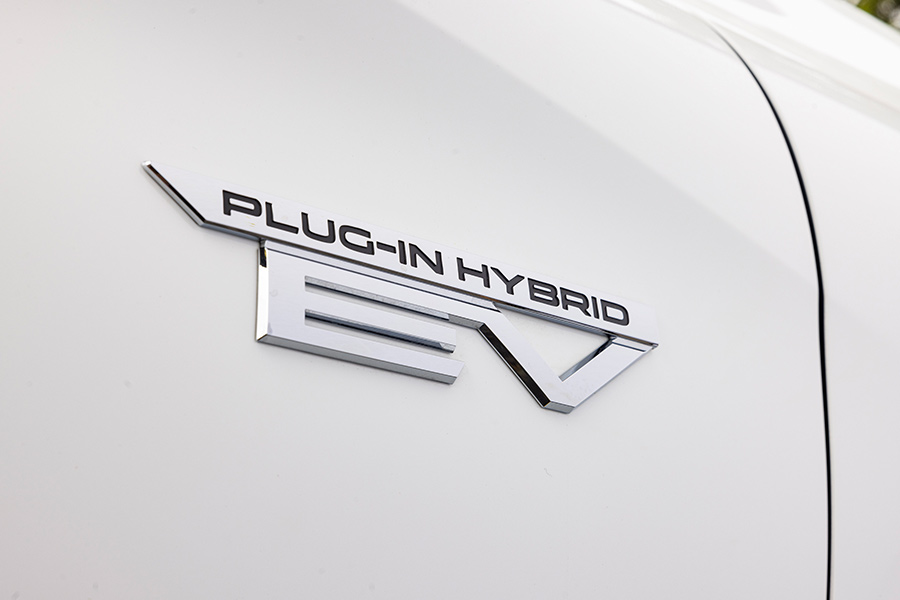
With a bigger capacity 20kWh lithium-ion battery pack (up from 13.8kWh in the previous model) and a larger 56L fuel tank (up from 45L), Mitsubishi claims the Outlander can travel for around 1000km between re-fills.
The bigger battery also improves the EV-only driving range to 84km, which is more than double the average daily commute for Australians and contributes to its remarkable claimed average fuel consumption of just 1.5L/100km.
But that lab-based test figure doesn’t quite represent the real world. During our road test period, we recorded an average city-based consumption of around 7.0L/100km.
However, if you recharge the battery every day then it is possible. And it’s not that difficult either, as Mitsubishi claims the Outlander’s battery can be replenished between 0-80 percent on a DC charger in around 38 minutes, or fully charged in just over six hours (overnight) on a 7kW home charger.
Mitsubishi also has the clever ‘Dendo Drive House’ which is a bi-directional charging system. Using the car’s CHAdeMO port the Outlander’s own power can be used to power a house or flow back into the grid.
Driving forward
The problem with plug-in hybrids (and fully electric cars) that counteracts the goal of efficiency is the added weight of the electric motors and heavy battery pack.
And it is especially noticeable in the Mitsubishi Outlander PHEV, which tips the scales at 2020kg, particularly when you’ve run out of electrons and need to rely solely on the petrol engine.
On the upside, the Outlander PHEV’s heft sits planted on the road and with all the electric assistance on offer it delivers surprisingly spritely response. The power delivery is immediate and the transition between EV and petrol power is seamless. Put simply, the Outlander PHEV is fuss-free driving.
Drive modes of Tarmac, Gravel, Snow and Mud as well as 199mm of ground clearance and decent approach (18deg) and departure (21.9deg) angles suggest the Outlander PHEV is in fact ready to head off the beaten track if you want to channel your inner Russell Coight.
The ride is both quiet and comfortable as the ES’s 18-inch wheels and higher-profile tyres work well on mixed suburban surfaces with little compromise to overall handling.
Confined to the suburbs and family duties (think school runs, sporting carpool and Vintage Cellars), the Outlander PHEV feels right at home. There’s a bit of play in the steering, but it’s light and easy to manoeuvre around town and parking its near five-metre footprint is a breeze. The Outlander PHEV wins many votes for ease of use.
All Mitsubishi Outlander PHEVs are capable of a braked towing capacity of 1600kg.
For the fleets
Priced to match its entry-level specification the Mitsubishi Outlander PHEV ES is a compelling package. While not perfect, the basics are done well.
The spacious cabin is family-friendly with solid ergonomics and robust fit and finish but doesn’t sparkle nor is it loaded with creature comforts.
The powertrain is impressive and can be ultra-efficient when used properly with an excellent EV-only driving range, and it drives nicely without excelling in any particular way.
All said, the Mitsubishi Outlander PHEV ES is a perfect stepping stone on the path to an electrified future, particularly for business fleets or those eligible for a novated lease.
2023 Mitsubishi Outlander PHEV ES at a glance:
Editor’s Rating: 7.7/10
| Price: $56,490 (plus on-road costs) |
Battery: 20kWh lithium-ion |
| Available: Now |
Range: 84km (NEDC) |
| Powertrain: 2.4-litre four-cylinder plug-in hybrid |
Fuel: 1.5L/100km (NEDC) |
| Output: 98kW/195Nm |
CO2: 35g/km (ADR Combined) |
| Combined output: 185kW/450Nm |
Safety rating: Five-star (ANCAP Year 2021) |
| Transmission: single-speed reduction |
|
Disclaimer: Images supplied by Carsales.
This article was prepared by an independent author. The information contained in this article represents the views and opinions of the original author, and is based on research carried out by the original author. The appearance of the article on Maxxia's website does not constitute an endorsement of its content by Maxxia in any way. The article has been made available for informational purposes only and should not be taken as advice. While all reasonable care has been taken to ensure that the statements made by the original author in the article are fair and accurate, Maxxia does not guarantee or warrant the accuracy or completeness of this information and will not be liable for, or in connection with, any loss or damage suffered as a result of any inaccuracies, errors or omissions or your reliance on this information. You should independently research and verify information before making any decision in respect of a vehicle.

